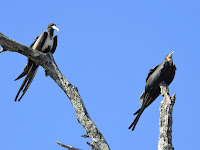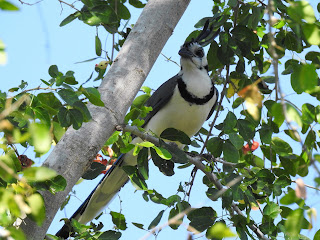Birding - Tweed Heads - Australia
A blog of bird photography walks. Mostly Tweed Heads Australia but other travels also.
Sunday, June 21, 2020
Sunday, February 23, 2020
The day I didn't go birding on Pipeline Rd in Panama
In February 2020 my wife and I were on the Holland America cruise ship the Rotterdam which left from San Diego and travelled south along the coast of Mexico and Central America before crossing through the Panama canal into the Atlantic. The transit of the canal was very interesting but we never actually set foot in Panama itself and our self imposed rule for counting countries we have visited involves us walking around outside of ports or airports so we decided to jump ship in Curacao and visit a few more Carribean destinations before heading back to the US and the rest of our trip.
This trip was not of course primarily about bird watching but I had spent a few days indulging myself birding in Hawaii and Colombia and on tours off the cruise boat so I didn't want to push my luck with the wife. So after checking out Panama City and the Biomuseo (arguably the best museum I have visited) on the first day, our second day was to head out to the Sloth Sanctuary at the Gamboa Rainforest resort.
We flew into Bogota Colombia and stayed for a few days then onwards to Panama City. We were very surprised at how modern Bogota was (which is a testament to our ignorance more than any reflection on Colombia) and when we saw the modern skyline of Panama City we were expecting a step up from our other central america visits but scratch the surface and Panama still has a 3rd world flavour. Taxi scams at the airport, that sort of thing. Not a biggie given our travel level but still a surprise.
 |
| Biomuseo Panama City |
You can't do a lot of advance planing when getting off a cruise ship part way as they can change their destinations and timings depending on weather and repairs and viral pandemics etc. So we sort of just winged it. We chatted to the Taxi driver outside the hotel and agreed on a price for the day to take us out to Gamboa and to the Rainforest retreat (he didn't wait for us but I didn't pay him either so meh. It was easy enough to get another ride from the resort). We were just in time to jump on a tour out to the forest canopy cable car ride. There was a tower at the end that you walked up in a very civilised fashion and looked out over the canal and the forest canopy. No birds though at around 3pm. We did see leaf cutter ants crossing the path on the way up though. Note to self, hold camera still.
We walked down from the cable car and went to the sloth sanctuary which is of course a zoo for tourists to look at sloths but still pretty cool but just outside the sloth shed was a butterfly enclosure and just outside that was a garden with lots of flowering plants and birds!
Many of these birds looked similar to the ones we had seen in Ecuador a few years ago.
 |
| Pale-vented Pigeon |
 |
| Southern rough-winged swallow |
 |
| Thick-billed Euphonia |
 |
| Ruddy Ground Dove |
Sunday, February 16, 2020
Tarcoles River Costa Rica
The 16th February 2020 saw Reagan and I on the Tarcoles River in Costa Rica. We were on the river at 9:30am which isn't bad for a tour off a cruise boat but perhaps a little late for the best birding. Most people were excited to see the crocodiles but it was the birds I was keen on of course.
Photography from a boat with a P900 is an exercise in frustration with a much higher rate of blurred images than normal. There is only so much that motion compensation can do with 2000mm of zoom and a slow focus system but I just went shutter crazy and took as many photos as I could. The boats were a sort of triple long BBQ barge so reasonably steady but we never really came to a stop.
My ebird record shows 32 species but not that many usable photos. There were scarlet macaws flying overhead but they didn't settle where I could get a photo.
The first two birds we saw didn't have their breeding plumage which is a shame because I would have liked to photograph the spots on the spotted sandpiper. The neotropic cormorant didn't have the white stripe behind the orange facial skin so could have been a juvenile.
The highlight of the trip was seeing a bunch of Egrets and Herons including the Tricolored Heron and the Little Blue Heron whose photos didn't make the cut.
The Roseate Spoonbill was hiding but the colour is still gorgeous.
A pair of Magnificent Frigate birds were posing on a perch which seemed a surprising place for them on the river but in truth we motored past the river mouth so they weren't that far from their usual coastal haunts. The predator is a Common Black Hawk.
The small lizard is a Common Baslisk. You can tell it's a male by the head crest. It also has a crest on its back and long tail. Nicknamed the Jesus lizard, juvenile Basilisks can run over water up to 20m to escape predators. The Bigger lizard is a crocodile.
I don't know what sort of Bats are in the photo below. They are tiny and look just like lichen on the underside of a log.
Photography from a boat with a P900 is an exercise in frustration with a much higher rate of blurred images than normal. There is only so much that motion compensation can do with 2000mm of zoom and a slow focus system but I just went shutter crazy and took as many photos as I could. The boats were a sort of triple long BBQ barge so reasonably steady but we never really came to a stop.
My ebird record shows 32 species but not that many usable photos. There were scarlet macaws flying overhead but they didn't settle where I could get a photo.
The first two birds we saw didn't have their breeding plumage which is a shame because I would have liked to photograph the spots on the spotted sandpiper. The neotropic cormorant didn't have the white stripe behind the orange facial skin so could have been a juvenile.
 |
 |
| Spotted Sandpiper | Neotropic Cormorant |
The highlight of the trip was seeing a bunch of Egrets and Herons including the Tricolored Heron and the Little Blue Heron whose photos didn't make the cut.
 |
 |
| Yellow-crowned Night-Heron | Yellow-crowned Night-Heron |
 |
 |
| Great Blue Heron | Great Blue Heron |
 |
 |
| Great Egret | Snowy Egret |
 |
 |
| Green Heron | Green Heron |
 |
 |
| Boat-billed Heron | Bare-throated Tiger-Heron |
 |
 |
| Roseate Spoonbill | Roseate Spoonbill |
 |
 |
| Magnificent Frigatebird | Common Black Hawk |
The small lizard is a Common Baslisk. You can tell it's a male by the head crest. It also has a crest on its back and long tail. Nicknamed the Jesus lizard, juvenile Basilisks can run over water up to 20m to escape predators. The Bigger lizard is a crocodile.
 |
 |
| Common Basilisk Lizard | Crocodile |
I don't know what sort of Bats are in the photo below. They are tiny and look just like lichen on the underside of a log.
Friday, February 14, 2020
Mexico Birding
On our second day in Mexico we went out with the explicit aim to photograph birds. We were able to spend our time getting photos and that showed with 30 species observed and 20 of those with photos. Sadly I couldn't get a decent photo of the Chachalaca which I wanted to photograph just because of the cool name but I did add them to the list. Most photos were from a park next to the Tangolunda beach that ran alongside a golf course and from the main road leading past the course; no bush bashing today.
It was stinking hot of course, 33ish. I started off with great enthusiasm at about 9:30am but by the end of four hours birding I was moving from shade spot to shade spot daring the birds to come to the camera and cursing them if I had to move into the sun to get the photo.
I would have liked to get a front facing photo of the Citreoline Trogon but even the back only view is quite spectacular.
I haven't seen many owls in Australia so seeing the Ferruginous Pygmy-owl in the middle of the day was a nice catch.
Huatulco, Oaxaca, Mexico is a tourist resort location with a port that can handle cruise ships. There are nine bays in close proximity with varying grades of resorts that attract the tourists but with the foothills of the Sierra Madre coming close to the coast it is also a great birding spot. The cruise port is a long floating jetty and as I walked off the Rotterdam I got to photgraph my first Great Kiskadee that was posing on a pylon.
 |
| Great Kiskadee |
Walking through the tourist shops at the port we saw three more birds. I had seen two of them the day before but it was a good start to the day.
It was stinking hot of course, 33ish. I started off with great enthusiasm at about 9:30am but by the end of four hours birding I was moving from shade spot to shade spot daring the birds to come to the camera and cursing them if I had to move into the sun to get the photo.
I tentatively identified a few Orioles. Australia only has three but it is rather more exciting in this part of the world. I have been playing an excellent board game called Wingspan which features 170 bird cards from North America and the Baltimore Oriole is a high value card so it was nice to see one for the first time in the wild. I am less sure of my other ID's. Fingers crossed.
I would have liked to get a front facing photo of the Citreoline Trogon but even the back only view is quite spectacular.
 |
| Citreoline Trogon |
Still haven't managed an Instragram worthy photo of the White-throated Magpie-jay. It is such a gorgeous looking bird it should lead to a winner everytime but the perfect photo still eludes me. Trying to get that enormously long tail in a photo with close enough detail and free from vegetation has been a task.
 |
| White-throated Magpie-jay |
I haven't seen many owls in Australia so seeing the Ferruginous Pygmy-owl in the middle of the day was a nice catch.
 |
| Ferruginous Pygmy-owl |
And a few other photos:
 |
| Black Vulture |
 |
| Social Flycatcher |
 |
| White-fronted Parrot |
 |
| Rufous-backed Robin |
 |
| White-winged Dove |
 |
| Orange-fronted Parrakeet |
 |
| Cinnamon Hummingbird |
 |
| Great-tailed Grackle - male |
 |
| Great-tailed Grackle - female |
 |
| Golden-cheeked Woodpecker |
 |
| Golden-cheeked Woodpecker |
 |
| Black Vulture |
Subscribe to:
Comments (Atom)
























